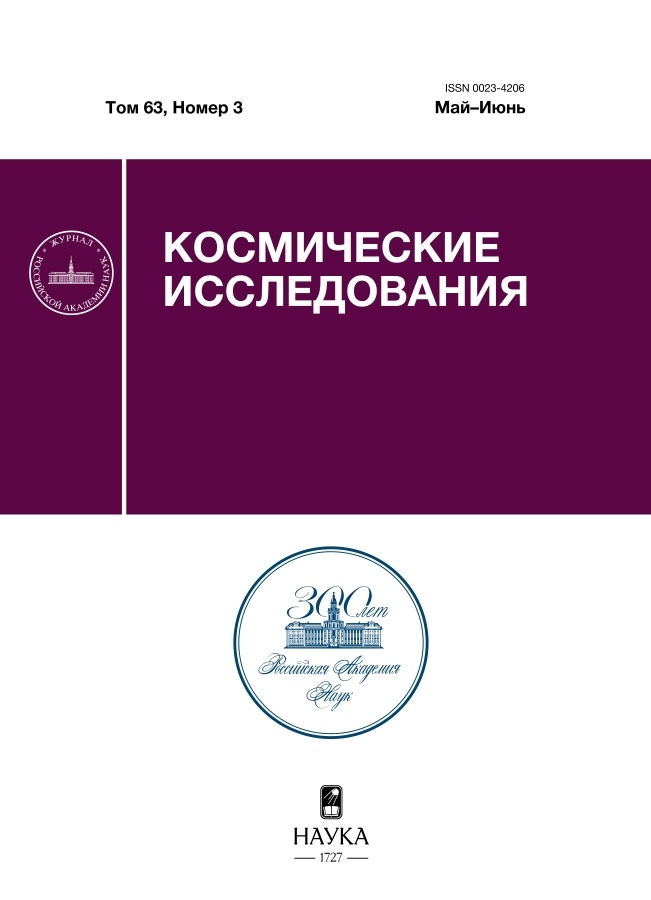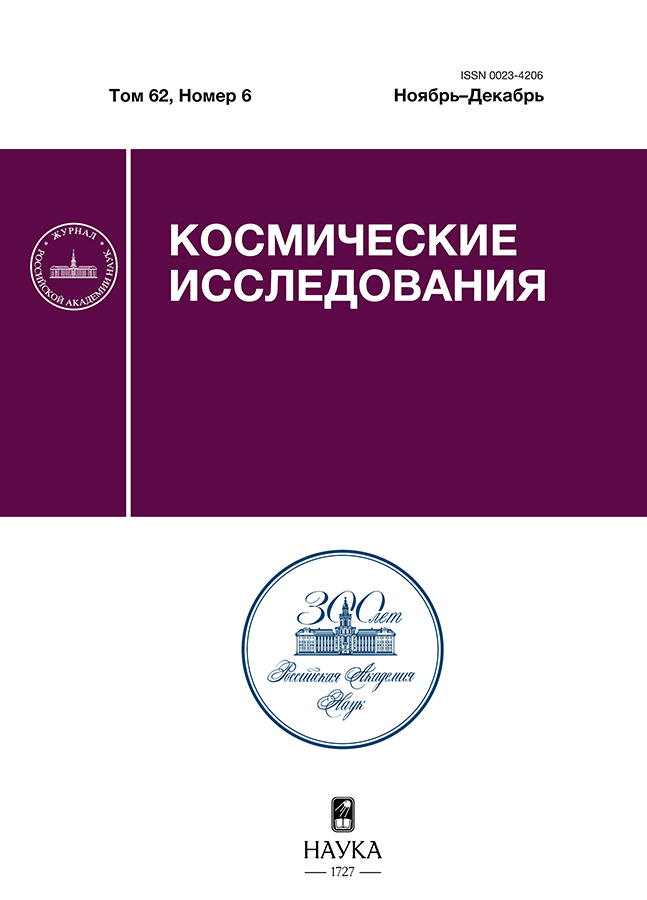Почему плотность ионов плазменного слоя зависит от плотности солнечного ветра?
- Авторы: Котова Г.А.1, Безруких В.В.1
-
Учреждения:
- Институт космических исследований РАН
- Выпуск: Том 62, № 6 (2024)
- Страницы: 565-576
- Раздел: Статьи
- URL: https://medjrf.com/0023-4206/article/view/672770
- DOI: https://doi.org/10.31857/S0023420624060014
- EDN: https://elibrary.ru/IGTRAQ
- ID: 672770
Цитировать
Полный текст
Аннотация
По измерениям тяжелых (M/q > 3) ионов на спутнике Фобос-2 было обнаружено, что плотность этих ионов в центральном плазменном слое ареомагнитного хвоста пропорциональна плотности протонов солнечного ветра, обтекающего планету. При сравнении данных спутника ISEE-2, измерявшего ионы в околоземном плазменном слое вблизи нейтрального слоя, с данными по солнечному ветру, полученными на спутнике ISEE-3, было установлено, что плотность протонов околоземного плазменного слоя также пропорциональна плотности протонов солнечного ветра. Анализ баланса магнитного и плазменного давлений в солнечном ветре и внутри хвостов магнитосфер Марса и Земли показал, что выявленные ранее корреляции являются следствием необходимого равенства давлений на границе магнитосферы и внутри магнитных хвостов планет.
Полный текст
Об авторах
Г. А. Котова
Институт космических исследований РАН
Автор, ответственный за переписку.
Email: kotova@iki.rssi.ru
Россия, Москва
В. В. Безруких
Институт космических исследований РАН
Email: kotova@iki.rssi.ru
Россия, Москва
Список литературы
- Rosenbauer H., Shutte N., Apathy I. et al. Ions of Martian origin and plasma sheet in the Martian magnetosphere: initial results of the TAUS experiment // Nature. 1989. V. 341. Iss. 6243. P. 612–614. https://doi.org/10.1038/341612A0.
- Розенбауэр Х., Шютте Н., Апати И. и др. Первые результаты измерений ионов марсианского происхождения и обнаружение плазменного слоя в магнитосфере Марса по данным эксперимента ТАУС на КА «Фобос-2» // Письма АЖ. 1990. Т. 16. № 4. С. 368–377. (Rosenbauer H., Shutte N., Apathy I. et al. First measurements of ions of Martian origin and observation of a plasma layer in the magnetosphere of Mars: the TAUS experiment on the spacecraft Phobos 2 // Soviet Astron. Lett. 1990. V. 16. Iss. 2. P. 156–160.)
- Verigin M.I., Rosenbauer H., Shutte N.M. et al. Ions of planetary origin in the Martian magnetosphere (Phobos-2/TAUS experiment) // Planet. Space Sci. 1991. V. 39. Iss. 1/2. P. 131–137. https://doi.org/10.1016/0032-0633(91)90135-W
- Petrukovich A., Artemyev A., Vasko I. et al. Current Sheets in the Earth Magnetotail: Plasma and Magnetic Field Structure with Cluster Project Observations // Space Sci. Rev. 2015. V. 188. P. 311–337. https://doi.org/10.1007/s11214-014-0126-7.
- Maggiolo R., Kistler L.M. Spatial variation in the plasma sheet composition: Dependence on geomagnetic and solar activity // J. Geophys. Res. 2014. V. 119 P. 2836–2857. https://doi.org/10.1002/2013JA019517.
- Котова Г.А., Веригин М.И., Шютте Н.М. и др. Ускорение тяжелых ионов в хвосте магнитосферы Марса по данным экспериментов ТАУС и МАГМА на космическом аппарате Фобос-2 // Косм. исслед. 1999. Т. 37. № 1. С. 31–37. (Kotova G.A., Verigin M.I., Shutte N.M. et al. Acceleration of heavy ions in the Martian magnetosphere tail by the data of the TAUS and MAGMA experiments on the Phobos-2 spacecraft // Cosm. Res. 1999. V. 37. Iss. 1. P. 27–33.)
- Kotova G.A., Verigin M.I., Shutte N.M. et al. Planetary heavy ions in the magnetotail of Mars: Results of the TAUS and MAGMA experiments aboard PHOBOS // Adv. Space Res. 1997. V. 20. Iss. 2. P. 173–176. https://doi.org/10.1016/S0273-1177(97)00529-2
- Borovsky J.E., Thomsen M.F., McComas D.J. The superdense plasma sheet: Plasmaspheric origin, solar wind origin, or ionospheric origin // J. Geophys. Res. 1997. V. 102. Iss. A10. P. 22089–22097. https://doi.org/10.1029/96JA02469.
- Borovsky J.E., Thomsen M.F., Elphic R.C. The driving of the plasma sheet by the solar wind // J. Geophys. Res. 1998. V. 103. Iss. A8. P. 17617–17639. https://doi.org/10.1029/97JA02986.
- Nagy A.F., Cravens T.E. Hot oxygen atoms in the upper atmospheres of Venus and Mars // Geophys. Res. Lett. 1988. V. 15. P. 433–435. https://doi.org/10.1029/GL015i005p00433.
- Ip W.-H. On a hot oxygen corona of Mars // Icarus. 1988. V. 76. P. 135–145. https://doi.org/10.1016/0019-1035(88)90146-7.
- Rojas-Castillo D., Nilsson H., Stenberg Wieser G. Mass composition of the escaping flux at Mars: MEX observations // J. Geophys. Res. 2018. V. 123. P. 8806–8822. https://doi.org/10.1029/2018JA025423.
- Kotova G.A., Verigin M.I., Remizov A.P. et al. Study of the solar wind deceleration upstream of the Martian terminator bow shock // J. Geophys. Res. 1997. V. 102. Iss. A2. P. 2165–2173. https://doi.org/10.1029/96JA01533.
- Rosenbauer H., Verigin M., Kotova G. et al. The relationship between the magnetic field in the Martian magnetotail and solar wind parameters // J. Geopys. Res. 1994. V. 99. Iss. A9. P. 17199–17204. https://doi.org/10.1029/94JA00946.
- Ohtani S., Kokubun S. IMP 8 magnetic observations of the high-latitude tail boundary: locations and force balance // J. Geophys. Res. 1990. V. 95. Iss. A12. P. 20759–20769. https://doi.org/10.1029/JA095iA12p20759.
- Shue J.-H., Song P., Russe C.T. et al. Magnetopause location under extreme solar wind conditions // J. Geophys. Res. 1998. V. 103. Iss. A8. P. 17691–17700. https://doi.org/10.1029/98JA01103.
- Веригин М., Апати И., Котова Г. и др. Зависимость размеров и формы магнитопаузы Марса от динамического давления солнечного ветра по данным спутника Фобос-2 // Косм. исслед. 1996.Т. 34. № 6. С. 595–603. (Verigin M., Apathy I., Kotova G. et al. Dependence of Martian magnetopause shape and its dimensions on solar wind dynamic pressure according to Phobos-2 data // Cosm. Res. 1996. V. 34. Iss. 6. P. 551–558.)
- Trotignon J.G., Mazelle C., Bertucci C. et al. Martian shock and magnetic pile-up boundary positions and shapes determined from the Phobos 2 and Mars Global Surveyor data sets // Planet Space Sci. 2006. V. 54. P. 357–369. https://doi.org/10.1016/j.pss.2006.01.003.
- Spreiter J.R., Alksne A.Y. Effect of neutral sheet currents on the shape and magnetic field of the magnetosphere // Planet. Space Sci. 1969. V. 17. P. 233. https://doi.org/10.1016/0032-0633(69)90040-3.
- Zhang T.-L., Schwingenschuh K., Russell C.T. et al. The flaring of the Martian magnetotail observed by the Phobos 2 spacecraft // Geophys. Res. Lett. 1994. V. 21. Iss. 12. P. 1121–1124. https://doi.org/10.1029/94GL01073.
- Bame S.J., Phillips J.L., McComas D.J. et al. The ULYSSES solar wind plasma investigation: Experiment description and initial in-ecliptic results // Solar Wind Seven. Eds. E. Marsch and R. Schwenn. Proc. the 3rd COSPAR Colloquium Held in Goslar. Germany. Pergamon. 1992. P. 139–142. https://doi.org/10.1016/B978-0-08-042049-3.50030-2.
- Baumjohann W., Paschmann G., Luhr H. Pressure balance between lobe and plasma sheet // Geophys. Res. Lett. 1990. V. 17. Iss. 1. P. 45–48. https://doi.org/10.1029/GL017i001p00045
- Знаткова С.С., Антонова Е.Е., Кирпичев И.П. и др. Давление плазмы под магнитопаузой на вечернем фланге в экваториальной плоскости при больших отрицательных ХGSM // Геомаг. Аэрон. 2018. Т. 58. № 6. С. 731–739. https://doi.org/10.1134/S0016794018060160. (Znatkova S.S., Antonova E.E., Kirpichev I.Pl, Pulinets M.S. Plasma pressure under magnetopause on the dusk flank in the equatorial plane for large negative ХGSM // Geom. Aeron. 2018. V. 59. P. 701–709. https://doi.org/10.1134/s0016793218060154.)
- Petrukovich A.A., Mukai T., Kokubun S. et al. Substorm-associated pressure variations in the magnetotail plasma sheet and lobe // J. Geophys. Res. 1999. V. 104. Iss. A3. P. 4501–4513. https://doi.org/10.1029/98JA02418.
- Petrinec S.M., Russell C.T. An empirical model of the size and shape of the near-earth magnetotail // Geophys. Res. Lett. 1993. V. 20. Iss. 23. P. 2695–2698. https://doi.org/10.1029/93GL02847.
- Nakai H., Kamide Y., Russell C.T. Influences of solar wind parameters and geomagnetic activity on the tail lobe magnetic field: a statistical study // J. Geophys. Res. 1991. V. 96. P. 5511–5523. https://doi.org/10.1029/90JA02361.
- Steinitz R., Eyni M. Global properties of the solar wind. I. The invariance of the momentum flux density // Astrophys. J. 1980. V. 241. P. 417–424. https://doi.org/10.1086/158355.
- Adebesin O.B., Ikubanni O.S., Kayode S.J. Solar wind dynamic pressure dependency on the plasma flow speed and IMF Bz during different geomagnetic activities // World J Young Researchers. 2012. V. 2(3) P. 43-54.
- Burlaga L.F., Ogilvie K.W. Magnetic and thermal pressures in the solar wind // Sol. Phys. 1970. V. 15. P. 61–71. https://doi.org/10.1007/BF00149472.
- Yang Z., Shen F.,·Zhang J. et al. Correlation between the magnetic field and plasma parameters at 1 AU // Solar Phys. 2018. V. 293. https://doi.org/10.1007/s11207-017-1238-5.
- Pérez-Alanis C.A., Janvier M., Nieves-Chinchilla T. et al. Statistical Analysis of Interplanetary Shocks from Mercury to Jupiter // Sol. Phys. 2023. V. 298. https://doi.org/10.1007/s11207-023-02152-3
- DiBraccio G.A., Espley J.R., Gruesbecket J.R. et al. Magnetotail dynamics at Mars: Initial MAVEN observations // Geophys. Res. Lett. 2015. V. 42. Iss. 21. P. 8828–8837. https://doi.org/10.1002/2015GL065248.
- Shutte N.M., Kiraly P., Cravens T.E. et al. Observation of electron and ion fluxes in the vicinity of Mars with the HARP spectrometer // Nature. 1989. V. 341. Iss. 6243. P. 614–616. https://doi.org/10.1038/341614a0
- Шютте Н., Кирай П., Кравенс Т. и др. Наблюдения потоков электронов и ионов в окрестности Марса при помощи спектрометра ХАРП на КА "Фобос-2" // Письма в АЖ. 1990. Т. 16. №. 4. (Shutte N., Kiraly P., Cravens T.E. et al. Observations of electron and ion flux in the vicinity of Mars using the HARP spectrometer on Phobos 2 // Soviet Astron. Lett. 1990. V. 16. Iss. 2. P. 154–156.)
- Kiraly P., Loch R., Szego K. et al. The HARP plasma experiment on-board the Phobos-2 spacecraft: Preliminary results // Planet. Space Sci. 1991. V. 39. Iss. 1/2. P. 139–146. https://doi.org/10.1016/0032-0633(91)90136-X.
- Halekas J.S., Brain D.A., Lin R.P. et al. Distribution and variability of accelerated electrons at Mars // J. Adv. Space Res. 2008. V. 41. Iss. 9. P. 1347–1352. https://doi.org/10.1016/j.asr.2007.01.034.
- Baumjohann W. The near-Earth plasma sheet: An AMPTE IRM perspective // Space Sci. Rev. 1993. V. 64. P. 141–163. https://doi.org/10.1007/BF00819660.
Дополнительные файлы





















